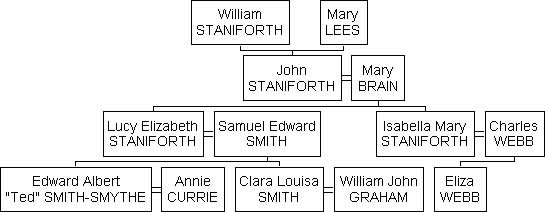The Convicts
Ted’s paternal ancestors
Ted's convict ancestors had come from central England between 1824 and 1835.
In St Swithuns, Worcester, England, Samuel Edward Smith was born to Samuel and Mary Smith about 1797. His brother James was born five years later. Other likely members of the family were Catherine (1791), Edward (1792), Thomas (1799) and Mary Ann (1808). The older children were all christened at St Michael, Bedwardine, an old parish, part of the city of Worcester. Samuel and James became cutlers. Strictly this referred to the tradesman who attached the handle to the blade, but was often used for anyone who made, sold or repaired knives and other cutting instruments. Samuel was also in the Rifle Corps, a group of respectable men selected to learn the skills needed when rifles replaced muskets. It was an elite corps, many were volunteers, and had a policy of encouragement instead of threats and punishment, which was the usual method of discipline at the time. They also wore dark green uniforms and a plain leather cap, a big break with the traditional Redcoat uniform.
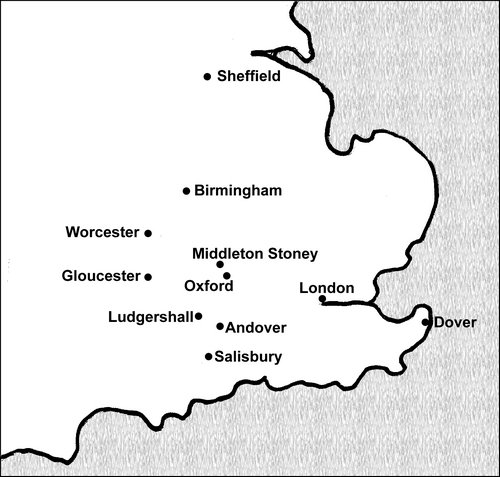 Click for larger map
Click for larger map
The Worcester area remained basically rural. Trade and communication had always been most important since Roman times especially at Gloucester twenty miles away. Both cities had beautiful ancient churches and other structures. The Industrial Revolution disrupted society in England. People flocked to the towns and lived in smoky, insanitary conditions, seeking work. Tuberculosis flourished. Many died of disease. Craftsmen became employers without any skill or understanding of management and basic business principles. New industries in the district, such as pin-making, did not exist for long. Many were closing down or going bankrupt, there was great social upheaval and for most people, life became a daily struggle to survive.
The brothers fell foul of the law and were thrown into gaol in Gloucester. Samuel and another man were charged with "breaking open the dwelling house of Jas. Barnes in the Island, in Gloucester." The Island was a piece of land between two forks of the Severn River. Apparently nothing was taken. Samuel was in gaol for seven months before he came to trial at the Gloucester Assizes* on 31st March 1824.
In January James was also apprehended and put in the same gaol. His trial was also on the same day, but in front of a different judge in a different court. He was "charged on the oath of Thomas Lane of the parish of Boddington, carpenter, on suspicion of having in the night of the eight day of Dec. last in company with George Jones and Helen Spriggs burglariously broken and entd the dwelling house of the sd Thomas Lane in Boddington aforesd and feloniously stolen taken and carried away therefrom a silver watch the property of the sd Thomas Lane."(sic) Helen Spriggs admitted evidence for the crown, and although her behaviour in custody had been "bad" she was discharged. All the men in both trials got the same verdict from both judges. "Death Recorded".
Parents' names are not mentioned; their grief was of no consequence to the court.
It happened that at the time the government was looking for people to fill a fleet of convict ships, so their death sentences were commuted to transportation to Van Diemen's Land, where tradesmen were in short supply.
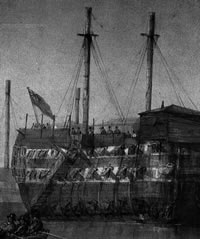
As the prisons were grossly overcrowded, they were sent in May to prison ships or hulks (usually rotting old naval vessels) to await the sailing of the next fleet to the Colony. Samuel was recorded as having a wife in Maidstone, Kent; of being five feet eight inches or five feet nine and a half inches depending on who measured him [1.72 m or 1.76 m] with hazel eyes and dark brown hair. Many men died while awaiting transportation, but the Smith brothers survived this period.
They were both allocated to the 400-ton "Princess Charlotte", sailing from The Downs, an area in the English Channel just off Dover. While on the voyage from London to Hobart via Falmouth and Rio, the surgeon had the responsibility for the 140 men on a long voyage through the tropics, mainly incarcerated below decks in dark, unventilated and stinking conditions. By this time the authorities were beginning to require better care of the prisoners and the mortality on the voyage was reduced. The routines of hygiene and activity were the same as for free immigrants to keep the men occupied. Food was supplied in a similar way using livestock kept on deck and pickled meat. Everyone who left England on the "Princess Charlotte" arrived safely if unwillingly in Van Diemen's Land. Convicts were in fact better fed than labourers at home. Samuel was the first of our ancestors to set foot on Australian soil in November 1824.
Launceston, Van Diemen’s Land
Governor Arthur was very strict about small misdemeanours, but most prisoners could get early release by compliant behaviour. Launceston was founded in 1804 and came to be used as a port to supply the new settlement of Port Phillip. It took up to ten days to cross Bass Strait, but this was quicker than getting supplies from Sydney. The population of Launceston was over 3000. The Law was represented by Magistrate Littleton who was also an artist, painting scenes of Launceston and the new Wesleyan Chapel. The Governor supported the Wesleyans (Methodists) who admired him and most of the convicts were Wesleyans.
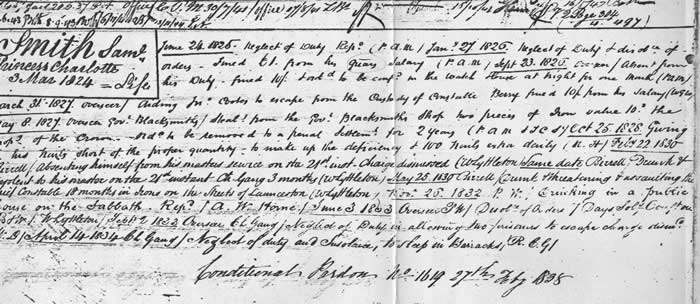 Samuel Smith's prison record in Van Diemen's Land
Samuel Smith's prison record in Van Diemen's Land
Surrounded by bush which felt as threatening as an enemy, prisoners lived in rude huts, twenty in each, and were men without hope, having little prospect they could ever lift themselves out of their degradation. Samuel, who was not a docile prisoner, was fined a number of times for neglect of duty. By 1827 he was working in a blacksmith's shop, making nails (probably the nearest thing in the Colony to his trade) when he was put into a chain gang for three months. Three years later he was in irons for eighteen months in the streets of Launceston for threatening and assaulting the chief constable. In 1832 he was caught drinking in a public place on the Sabbath 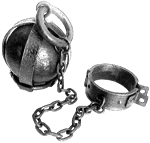 and came before Magistrate Littleton.
and came before Magistrate Littleton.
The next year Samuel was overseer of a chain gang when two prisoners escaped and he was charged with neglect of duty. This case was dismissed.
Mary Ann Raffell
After seven years Samuel’s previous marriage was automatically annulled.
Five men to every woman were transported, so there was a drastic imbalance, but Samuel had sufficient good qualities to attract a young widow who had arrived in the Colony as a convict, Mary Ann Raffles (Roffles) on the "Harmony" in 1829 with ninety-nine other female convicts. She had been transported for seven years for stealing from her mistress while working at Somerton near Islington, London. Described as a "servant of all work", aged eighteen, she had dark brown hair and eyes, a medium large nose, with deep pock marks on her oval face and chin, and was diminutive, only four feet nine inches [1.45 m]. A year after her arrival she got permission to marry a labourer, John Payne. As soon as possible women attached themselves to a man for protection. They had three children, Henry, Eliza and Louisa, the youngest born after John's death. Mary Ann became free by servitude. When Samuel was thirty-eight and Mary Ann was twenty-four they married in 1835 in the Anglican Church of St John, her children were five, four and one. Samuel could write his name but she signed with a cross.
Two years later Samuel and Mary Ann had a son, also Samuel Edward. By this time Samuel senior was working as a blacksmith. He was granted a conditional pardon on 27th February 1838 after serving fourteen years. A conditional pardon meant that he could not return to his homeland had he wanted to or been able to afford it. Having gained his pardon, he had to support himself and family, including stepchildren, although times were very hard. Few children got any education.
Transportation to NSW had ceased, resulting in more convicts being sent to Van Diemen's Land, which caused an oversupply of labour during a depression, and people who could leave did so. Some with a free pardon, worked their passages back to their homeland, others tried to get to the mainland.
In the following years Samuel and Mary had other children, James when his father was working at his trade of cutler, and Mary when he was labouring. In 1847 Samuel was again a cutler, living in George St when they had a daughter Rebecca who died at the age of four. They also had a son who about the same time died of a scalding at sixteen months. In 1848 they were living in Balfour Street.
Meanwhile Samuel's brother James had had a similar chequered servitude, with punishments of twenty-five lashes, confinement for fourteen days on bread and water, six hours in the stocks. His crimes included riding his master's horse into Launceston from the Cocked Hat Hill*, contrary to his master's orders, for which he got fifty lashes. He got his conditional pardon in 1838 the same year as his brother and a free pardon in 1842. In 1859 at the age of 57 he married Mary Duffy a widow, his brother Samuel being a witness.
Ted’s maternal ancestors
Mary Brain
About 1779 Elizabeth Fuller, widow, married Benjamin Goode, at St Giles Cripplegate, Shoreditch, a church dating from 1099. Their daughter Mary Goode met Anthony Brain, the son of Thomas Brain and Elizabeth Ryeman, who lived at Middleton Stoney, Oxfordshire and married in 1789. Middleton Stoney had once been an important town with a fine old church from the twelfth century and the remains of a baronial castle destroyed in 1216, but was now a tiny village and destined to decline further. However the children of the villagers were educated in three day-schools and evening classes for older boys.
 Middleton Stoney, then and now
Middleton Stoney, then and now
In 1803 Anthony Brain, stonemason, and Mary Goode married at St Giles, Cripplegate, where she had been baptised. By 1819 they had had six children; Lucy, John (both died in infancy) Elizabeth, John second, Mary and Thomas, all baptised at St Leonard's Shoreditch. When Anthony's mother died his father remarried, making a will in which he left his property, land and two cottages, to his second wife during her lifetime, then to his children by his first marriage.
During the Industrial Revolution orderly society began to collapse. In the 1830s living conditions in UK for the poor were the worst for hundreds of years, great hardship and malnutrition were common. There was uncertainty even for those who were moderately well off and literate.
John Brain began his working life as a messenger for a traveller in stationery. In 1832 he was a dark-haired youth of nineteen, and only five feet three inches [1.6m] tall, which would not have been particularly remarkable at the time due to harsh living conditions. He was convicted of stealing an order of payment for £41.13.4 from a desk at the establishment where the traveller was employed. At his trial John said he was sorry for his actions and as it was his first offence, "I shall throw myself on the mercy of the Court". The Prosecutor and Jury recommended mercy. He was sentenced to Transportation for life and was sent to Van Diemen's Land.
About the time of John's trial his grandfather aged eighty-seven and his second wife both died, and were buried at Middleton Stoney. Anthony inherited his share of the property. The family decided to sell and Anthony, Mary and their three remaining children went to Van Diemen's Land to join their son and brother. The girls Elizabeth (twenty-four) and Mary (nineteen) got free passage, as there was a great shortage of females. Two houses had been hired near St John's Square, Launceston for their accommodation. The family including fifteen-year-old Thomas, arrived in 1835 on the "Charles Kerr" as free immigrants. Anthony had come to work for Mr L.A. Brown at eight shillings a day. The daughters were soon allowed to join their parents. The girls had plenty of choice of husbands and were not under pressure to marry in haste for protection as they had family. A few days after his arrival Anthony paid £45 for land high up York St, with views of the town of Launceston, the sale being completed two years later. That part of York St was a steep track used by gangs of convicts on their way to and from the sawpit on top of the cliffs above Broadwater. A cottage was built about 1840 with garden walls built by Anthony. Their older daughter Elizabeth grew an orange tree from seed while living in Brisbane St. It was moved in a toy wheelbarrow about 1842. Within a year Elizabeth married James Peppiatt who had arrived as a convict nine years earlier. Mary met John Staniforth in Launceston.
John Staniforth - Ted’s maternal grandfather
In Sheffield, the biggest town in Yorkshire, England, John Staniforth was born in 1806 to William Staniforth and Mary (Lees). The name Staniforth was very much a Sheffield name, meaning stony ford and still abounds in the district. It had arisen before the fourteenth century. Records refer to the "Staniforths of Staniforth"*. The ford was in the eastern part of the present city near Wincobank, over the Don or Blackburn Brook.
Many farmers and farm labourers earned extra income in home industries as cutlers. Sheffield knives (thwitels) were mentioned in "Canterbury Tales" and the town became an international centre by the eighteenth century. There was timber to heat the furnaces to make charcoal needed by the flourishing industry and water to temper the steel. The population increased tenfold during the Industrial Revolution but disease flourished especially lung disease in low-lying areas.
John, five feet five inches tall [1.65m] became a labourer and cutler. He was a widower, when he was convicted of "combination", trade union activity, for which he served six months. He was once acquitted of an offence, before being convicted of stealing wearing apparel and sentenced to seven years. According to his gaol report he had a bad character and connections. While on a hulk his behaviour was good. In 1834 the recently built "Augusta Jessie" sailed from London to Portsmouth and then to Hobart Town with 210 male prisoners including John. The experienced ship's surgeon had made the voyage several times, but three men died during the 115-day passage. John was permitted to live in Launceston in the employ of Mr Yates who had a property at Cocked Hat Hill, south of Launceston. From then on his record was clean.
John Staniforth aged thirty-two and Mary Brain, aged twenty-two had a child who was named Lucy Elizabeth like Mary's sister who had died in England. The baby was nine months old when her parents got permission to marry. The bride's father, Anthony Brain and her married sister, Elizabeth Peppiatt, were their witnesses. John Staniforth signed with a cross. In 1841 he got a ticket of leave having served six years. This gave the status of a probationer, released to work for local land owners. Another daughter, Isabella Mary was born six years after Lucy.
Anthony Brain continued to work as a stonemason and builder in the Launceston area, and the family was later shown places he had built including a wall at his property 304 York St.
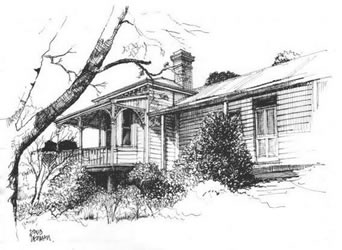
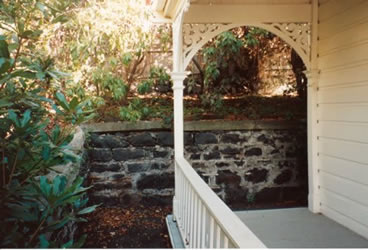 The property was later bought by Anthony’s grandson James Peppiatt and became The Peppiat House. The wall built by Anthony Brain was still standing in 2003.
Additions and alterations have been made to the heritage house,
which has been lived in by six generations of his descendants. Aboriginal beads donated by James Peppiatt were on display in Launceston Museum in 2003.
The property was later bought by Anthony’s grandson James Peppiatt and became The Peppiat House. The wall built by Anthony Brain was still standing in 2003.
Additions and alterations have been made to the heritage house,
which has been lived in by six generations of his descendants. Aboriginal beads donated by James Peppiatt were on display in Launceston Museum in 2003.
His son John got his ticket of leave and married Sophia Jessop the daughter of a convict, James Jessop, transported in 1812. John and Sophia had a large family and John was involved in a lot of stonemasonry work in the town. Anthony's younger son, Thomas, fifteen on arrival in Van Diemen's Land had started work as a clerk, at ten shillings a week. He became an accountant and a teacher, finally a headmaster. He married Sarah Hall.
In the meantime Van Diemen's Land had been granted responsible government and the name changed to Tasmania. There was an over-supply of convict labour, and free settlers were taxed to support them. Transportation ceased in 1852. By then 67,000 prisoners had been sent there, the total population had reached 69,000. Life was not easy.
Anthony was living in Brisbane St near Wellington St, and had been officiating as a Clerk at the Holy Trinity, witnessing many marriages until 1846. His health was declining and he suffered from an enlarged heart.
One day Anthony and his son John were walking along the street when Anthony was suddenly taken ill. He sat down for a few minutes to rest. On rising, his limbs "refused to perform their office". John placed him on the ground where he "soon expired". His wife, Mary, died ten years later and was buried beside him. By this time there were twenty-two living grandchildren, among them Lucy Staniforth.
In 1857 John Staniforth died of consumption (most likely tuberculosis which was common at the time) when Lucy and Isabella were twenty and fourteen. The death certificate stated he was sixty-two, but by other records he would have been fifty-one at the time. Three years after John died, his widow, Mary (Brain) married a widower, James Bellion, a master mariner, and recently a pilot at Low Head. They were married aboard the "Sylph" on which he lived. Women had no trouble getting husbands. She was to live to the age of eighty-eight, outliving her second husband.
Birth of Ted Smith
When Lucy was twenty-two she also had a nine month old baby (our grandfather) when she married Samuel Smith junior, the child's father, at the residence of John Brain, Lucy's uncle the ex-convict, in Balfour St, Launceston in 1860. The witnesses were James Bellion, Lucy's stepfather and her aunt Elizabeth (Brain) Peppiatt. They called the baby Edward Albert, very popular names in the Victorian era, Albert being Queen Victoria's German-born consort who died two years later. The baby's father and grandfather were both Samuel Edward. It was common to abbreviate Edward to Ted. Of his grandparents, two had trades, one was a member of the Elite Rifle Corp, one ancestor was a stonemason.
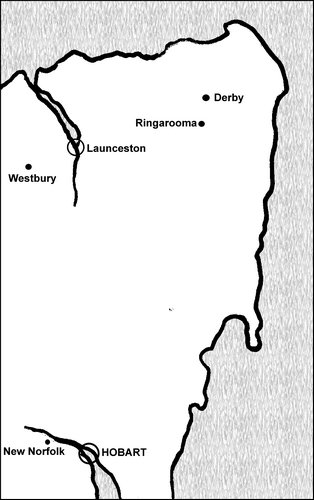 Click for larger map
Click for larger map
His grandmothers, Mary (Hawke) Smith and Mary (Brain) Staniforth were in their forties when Lucy and Samuel were married. Samuel was working as a butcher at the time, perhaps at the public slaughterhouse in Balfour St (where they had lived). The following year Clara Louisa was born. When she was baptised three years later, in the Wesleyan Church, her father was a labourer. When the children were aged nearly six and four years old, their mother died of consumption, aged twenty-seven, eight years after their grandfather, John Staniforth, had died from the same cause.
Ted and Clara had three grandparents who had arrived in Van Diemen's Land as Guests of the Crown; the fourth was the step-mother of such a guest. Both their grandmothers and the three known great-grandmothers were all called Mary, which adds to the confusion!
After their mother died, Ted and Clara were apparently cared for by the extended family* until their father aged thirty-one married Louisa Sophia Breadon, a seamstress aged twenty-seven. Louisa had been briefly married to a forty-six year old widowed engineer who had died from a heart attack.
In the following years, young Ted and Clara had half brothers and sisters including James, Herbert, Percy and Samuel Louis. Ted was reputed to be difficult as a boy. He was slow and fastidious and this may have annoyed his stepmother. He attended Launceston Grammar School for a while and enjoyed science in particular. His name is not on the roll, only the note from 1873 "Smith not recorded". In spite of a lack of formal education he developed a mature handwriting and an interest in improving his knowledge. High school education was expensive and out of the reach of most people. The wealthy often sent their children abroad. Clara attended Miss Windeatte's School. Later, the family moved to Ringarooma. It seems their father got a job on the nearby railway as he was listed as a porter and storeman at different times.
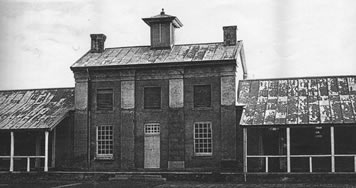 Royal Derwent Hospital, Tasmania
Royal Derwent Hospital, Tasmania
When Ted was eighteen and Clara sixteen their father, Samuel was admitted to the Royal Derwent Hospital. The hospital had been built at New Norfolk by Governor Arthur, fifty years earlier, originally one end for the sick and the other end for insane convicts from the outstations and later "for the reception of such convicts as through age and infirmities have been unable to labour". By this time it was a mental asylum. Samuel was described as a porter at Westbury (near Launceston) an active, strong, well-built man aged forty-one, in good health. His problem was not diagnosed and apparently he went home. The following year, Ted's grandfather, Samuel Smith, the ex-convict, listed as a locksmith, by then about eighty died of erysipelas, an infectious disease. His widow Mary, died of senility the next year, aged sixty-seven.
Ted's father was later re-admitted to hospital, suffering from religious mania, sometimes feeling quite desperate. His eyes had a peculiar wild look. His wife, Louisa said he constantly wrote letters to avoid seeing people. He was normally a quiet well-behaved man but had begun to ill-treat her. In January 1881 he had an attack of ophthalmia (an eye disease), in June was seized with severe epileptic fits*, by October he had another seizure, became comatose and died. The Post Mortem found he had a brain much congested on the right side, with a quantity of blood in the surrounding tissue. The diagnosis was apoplexy (stroke) and brain disease.
One evening soon afterwards Ted was going out and was told by his stepmother, Louisa, to be home by ten pm. He came home at five past and found himself locked out. The relationship deteriorated. He left Tasmania about 1881 and went to Melbourne where he learnt bootmaking. He learnt to be a perfectionist and never do a shoddy piece of work.
Whether or not he knew of his convict past, he left it behind. He believed his future was in his own hands.
It would appear that Ted's sister, Clara got on with her stepmother. At the age of seventeen she was given a Bible dated 11th April 1878, a birthday gift from "her affectionate mother and father" (her step-mother, Louisa). Clara grew to be less than five feet [1.52m] in height, like her paternal grandmother Mary Raffles/ Payne/ Smith.
In time she met William John Graham; born in 1853 the son of Ellen Graham who had come to Van Diemen's Land in 1840 as a convict from Glasgow. William must have got some education, as he was later able to keep a lot of farm records. In 1886 Clara and William married, the witnesses being Louisa, her widowed stepmother and Alfred Gee, (the man Louisa later married, as her third husband in a ceremony witnessed by Clara).
The next year William had a butcher's shop and about ten years later bought a farm "Bonnie Doon" in Graham's Lane, Derby. On Saturday some of the locals would go to the farm to get meat, so apparently he continued with some butchering. Clara and William Graham lived in the Derby District for many years and had ten children.
NEXT >>



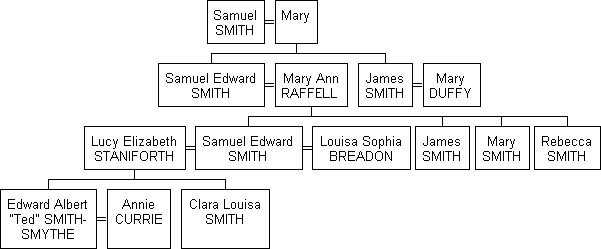

 and came before Magistrate Littleton.
and came before Magistrate Littleton. 

